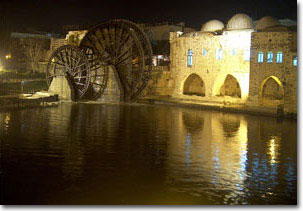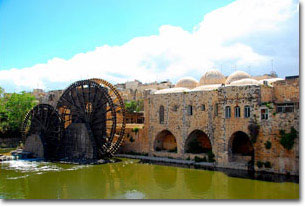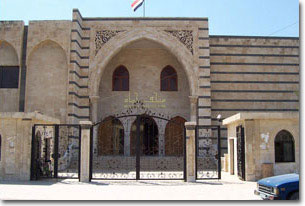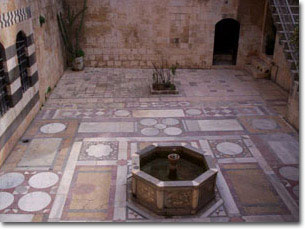|
 47 km north of Homs, 209 km north from Damascus lies Hama that, in the past, enjoyed a reputation as one of the more charming of the Syrian towns, more successful than most in making of its environment a pleasant and picturesque setting through the use of the Orontes as the city's lungs and cooling device. 47 km north of Homs, 209 km north from Damascus lies Hama that, in the past, enjoyed a reputation as one of the more charming of the Syrian towns, more successful than most in making of its environment a pleasant and picturesque setting through the use of the Orontes as the city's lungs and cooling device.
History:
Hama citadel hill which you will find to the north west of the center of the city (today a park crowns the summit) has been exhaustively researched over the years, particularly by a Danish expedition. Traces have been found of all periods as far back as the Neolithic, including the 11th century BC, when Hama was the center of the small Syro-Hittite or Aramean kingdom of Hamath. Some of the evidence is now on display in the museum.
The city was destroyed by Assyrians in 720 and, like the rest of Syria, came under Assyrian and Persian rule. Then the Seleucids established their presence after 200 BC and renamed the city Epiphania after one of their foremost rulers, Antiochos IV Epiphanes. It remained a center of Roman and Byzantine administration, falling to Arabs by capitulation in 636 - 7.
The Ayyūbid period was particularly prosperous and saw the construction of the first of the existing norias (the enormous wooden water wheels), reconditioned and supplemented in the Mameluke and Ottoman periods. During 16th century and from the 18th century, Hama was under Damascus control in an effort to maximize the returns from the pilgrimage - hence the strong link between the two towns through the Azem family.
The Norias:
 The town has 17 norias in the center of town, in the Orontes pushing water when it's weakly flowing. The great wheels, up to 20 m in diameter, were designed to raise water from the Orontes. The river's flow is channeled by a dam into a sluice which drives the wheel. This raises the wheel's wooden box devices that trap water and discharge it at the top of its rotation into towers at the side. From the towers, the water flowed through stone aqueducts into the town or surrounding agricultural areas, each consumer being allocated a portion of the flow over a period of time. Hama specialized in these devices since the Byzantine times. The largest example is the central group named al-Mamuriye and dates from 1453 (Mamelukes period). The town has 17 norias in the center of town, in the Orontes pushing water when it's weakly flowing. The great wheels, up to 20 m in diameter, were designed to raise water from the Orontes. The river's flow is channeled by a dam into a sluice which drives the wheel. This raises the wheel's wooden box devices that trap water and discharge it at the top of its rotation into towers at the side. From the towers, the water flowed through stone aqueducts into the town or surrounding agricultural areas, each consumer being allocated a portion of the flow over a period of time. Hama specialized in these devices since the Byzantine times. The largest example is the central group named al-Mamuriye and dates from 1453 (Mamelukes period).
The Museum:
 Watching the museum will be educating because of its contents, Bronze Ages and Iron Age through to the Ayyūbid and Mameluke periods. This museum is housed in the Hama Beit Azem (Azem Palace), the 18th century mansion of a former wali (governor) of Hama, Assaad Pasha al-Azem (1705 - 57, wali of Hama pre-1742 and of Damascus in 1743 - 57). The collection of objects is displayed in a number of rooms in addition to the Roman and Christian remains found in the lower courtyard. Particularly worthy of note is the mosaic of Mariamin (west of Homs, in the edge of the Jebel Ansariye). The work is from the last quarter of the 4th century. Watching the museum will be educating because of its contents, Bronze Ages and Iron Age through to the Ayyūbid and Mameluke periods. This museum is housed in the Hama Beit Azem (Azem Palace), the 18th century mansion of a former wali (governor) of Hama, Assaad Pasha al-Azem (1705 - 57, wali of Hama pre-1742 and of Damascus in 1743 - 57). The collection of objects is displayed in a number of rooms in addition to the Roman and Christian remains found in the lower courtyard. Particularly worthy of note is the mosaic of Mariamin (west of Homs, in the edge of the Jebel Ansariye). The work is from the last quarter of the 4th century.
Mosque al- Nūri:
 North of Beit Azem, the Mosque al-Nūri stands on a square where a small bridge crosses the Orontes. It was completed in 1163 by Nūr al-Din the Zengid. The admirable minaret, banded with black basalt and yellow limestone, is original. The minbar (tribune) within (12th century), a gift of Nūr al Din, is worth noting. There are other remarkable mosques to visit: Mosque al-Izzi, Mosque and Mausoleum of Abu al-Fida and the Great Mosque of Hama. North of Beit Azem, the Mosque al-Nūri stands on a square where a small bridge crosses the Orontes. It was completed in 1163 by Nūr al-Din the Zengid. The admirable minaret, banded with black basalt and yellow limestone, is original. The minbar (tribune) within (12th century), a gift of Nūr al Din, is worth noting. There are other remarkable mosques to visit: Mosque al-Izzi, Mosque and Mausoleum of Abu al-Fida and the Great Mosque of Hama.
Khans:
There are two Ottoman khans to be seen. The 1556 Khan Rustum Pasha has large courtyard, vaulted arcades on four sides and the central mosque. And the huge façade of the Khan Assaad Pasha (1738) also resemble to the former, both being restored by the Ministry of Tourism.
|


